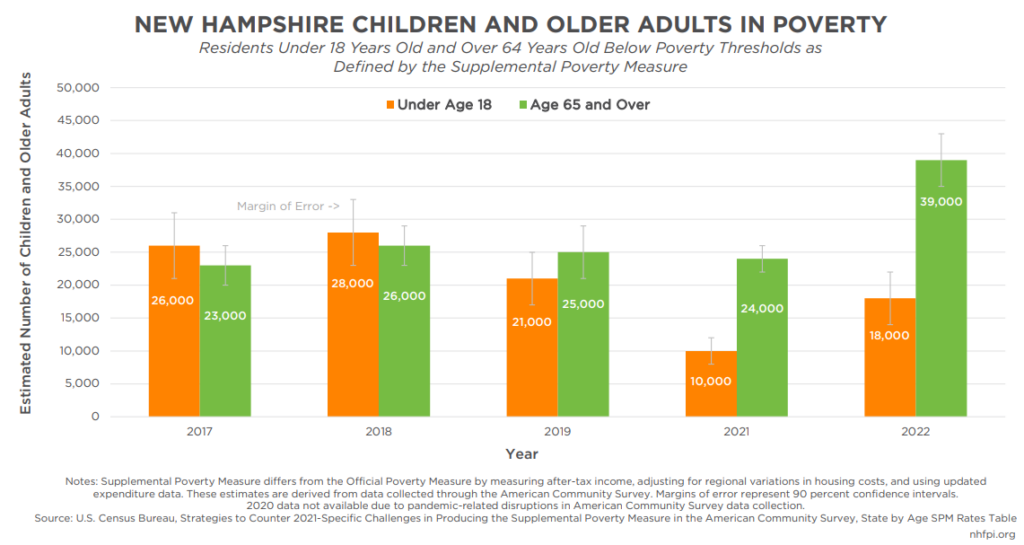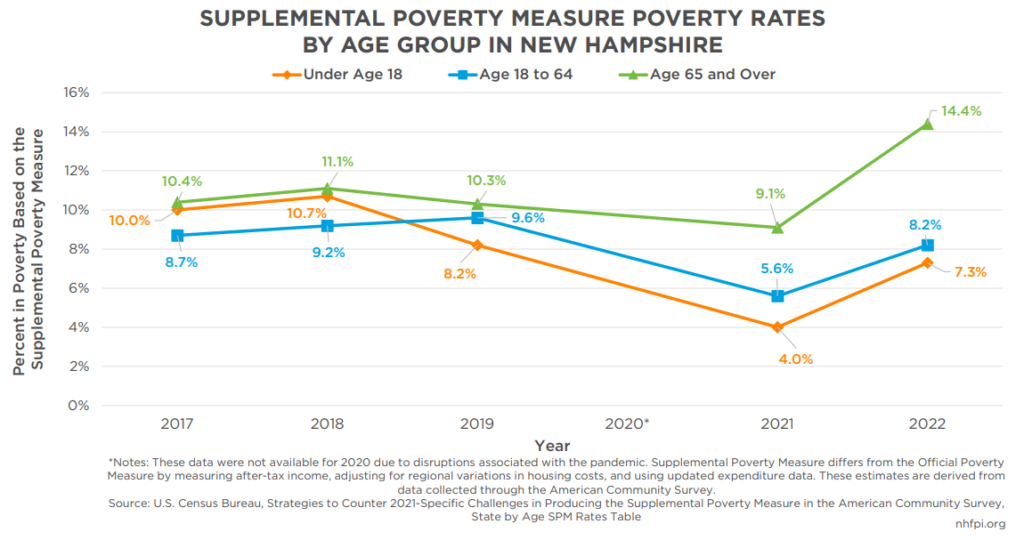New data released this Spring show substantial swings in poverty rates, largely in response to policies intended to offset the negative impacts of the COVID-19 pandemic. After falling to a historically low level in 2021, a key measure of child poverty in New Hampshire rebounded in 2022. Also in 2022, poverty among older adults rose to the highest rate since at least 2012, a period of higher poverty during the aftermath of the Great Recession of 2007-2009. Overall, estimates show about 45,000 more New Hampshire residents were in poverty in 2022 than in 2021, which was a rebounding to approximately the poverty levels of 2017, 2018, and 2019. While slower inflation and other early indicators suggest poverty may have eased since the end of 2022, the 2021-to-2022 increase shows higher poverty levels, particularly among older adults, than prior data identified.
Detailed Data Following Delay
The U.S. Census Bureau releases state-level estimates each year showing the number of people in poverty, and the poverty rate, as defined by the Official Poverty Measure and based on data collected by the American Community Survey. The Official Poverty Measure uses pre-tax income and is based largely on the costs of a specific set of food, adjusted for household size and inflation. The Official Poverty Measure poverty threshold throughout the contiguous 48 states in 2022 was $15,225 annually for an individual less than 65 years old, $23,556 for a family of three with one child, and $29,678 for a family of four with two children.
While a longstanding measure, researchers and the U.S. Census Bureau have worked to identify other measures of hardship beyond the Official Poverty Measure. One of these measures is the Supplemental Poverty Measure (SPM), which uses ongoing survey data to estimate expenditure costs for food, clothing, utilities, and housing costs. The SPM includes regional variation in housing costs, which the Official Poverty Measure does not. The SPM also includes the effects of taxes and tax credits, nutrition and energy assistance, work and medical expenditures, child support payments, and child care costs. Federal data estimating the historical SPM poverty rate are available to 2009, as the measure is relatively new.
In recent years, the U.S. Census Bureau has made an effort to estimate the SPM at the state level using models to interpret data collected by the American Community Survey. While 2020 data are not available because of disruptions associated with the pandemic, these analyses allow examination, with a greater level of detail than previously available, of poverty in New Hampshire before and since the start of the pandemic. This added layer of analysis to produce SPM estimates at the state level resulted in the delayed release of these data. Using the SPM, rather than the Official Poverty Measure, is critical for understanding how key assistance, much of which was delivered through the federal tax code and thus is not accounted for in the Official Poverty Measure, affected the financial well-being of individuals and families in New Hampshire.
Child Poverty Plunges, Then Rebounds
The assistance provided by the federal government through the tax code had a profound impact on poverty, particularly among children, due to targeted policies designed to alleviate hardship for families. Foremost among these was the one-year expansion made to the Child Tax Credit. This expansion resulted in larger amounts of aid reaching more households with children, as well as assistance being delivered in a more timely manner than in a typical tax year. The Economic Impact Payments, which were sometimes called “stimulus checks,” also substantially reduced poverty nationwide, and in 2021 were provided on a per-person basis to households. These initiatives, among others, directed more resources to families with children.
The New Hampshire-level poverty data released this Spring provides insights into the extent to which federal assistance was targeted to households with children and low incomes, effectively reducing poverty for this group. While 2020 data are not available, the number of children under 18 years old in SPM poverty dropped from an estimated 28,000 in 2018 and 21,000 in 2019 to 10,000 in 2021. The Economic Impact Payments were one-time policies, however, and the expansions to the Child Tax Credit expired after 2021. SPM poverty rebounded in 2022, with an estimated 18,000 children in poverty in New Hampshire.
The SPM poverty rate for children under 18 in New Hampshire was about 10.7 percent in 2018 and 8.2 percent in 2019. In 2021, child SPM poverty was reduced to 4.0 percent, and then increased to 7.3 percent in 2022. That change is a much larger swing than the concurrent change in the overall SPM poverty rate, which decreased from 9.5 percent in 2019 to 6.0 percent in 2021 before rising back to 9.3 percent in 2022. During this time period, the statewide poverty rate, according to the Official Poverty Measure, was relatively steady, showing the insights into hardship and well-being provided by the SPM poverty rate that are missed in the Official Poverty Measure.
Poverty Rising for Older Adults
For New Hampshire residents age 65 years and older, however, both the Official Poverty Measure and the SPM show increasing poverty in 2022 relative to 2019. While the Official Poverty Measure poverty rate increased from 6.2 percent to 7.9 percent between those two years, SPM poverty increased more substantially, from 10.3 percent to 14.4 percent.
The 2022 SPM poverty rate increase translates into approximately 15,000 more older Granite Staters living in poverty in 2022 than in 2021, and about 14,000 more than in 2019. SPM poverty did not decline significantly for older adults in 2021 as it did for children and for younger adults, who were potentially more likely to be the parents of children eligible for expanded assistance. The poverty rate of 14.4 percent is higher than any SPM poverty rate for older adults in New Hampshire since at least 2012, and the number of older adults in SPM poverty is approximately twice the corresponding estimated numbers during 2009 and 2014-2016, which was followed by increasing poverty among older adults.
Policy Lessons and Implications
As other data have previously indicated at the national level, federal policies in 2021 substantially and meaningfully reduced child poverty in New Hampshire, and the expiration of those policies in 2022 coincided with a rebound in poverty among Granite Staters under 18 years old. Ongoing research and analysis of the effectiveness of policy solutions deployed in response to the COVID-19 pandemic could provide insights into efficient ways to target resources toward reducing hardship and boosting the economy outside of emergency situations. Additionally, rising poverty among older adults in New Hampshire may reflect more Granite Staters entering this age group with fewer steady sources of robust income, as well as higher costs for housing, food, and other necessities relative to past years. While inflation has declined substantially since 2022, these poverty data indicate many individuals and families have faced significant hardships following the expiration of policies providing financial supports to both households and the economy.
– Phil Sletten, Research Director


